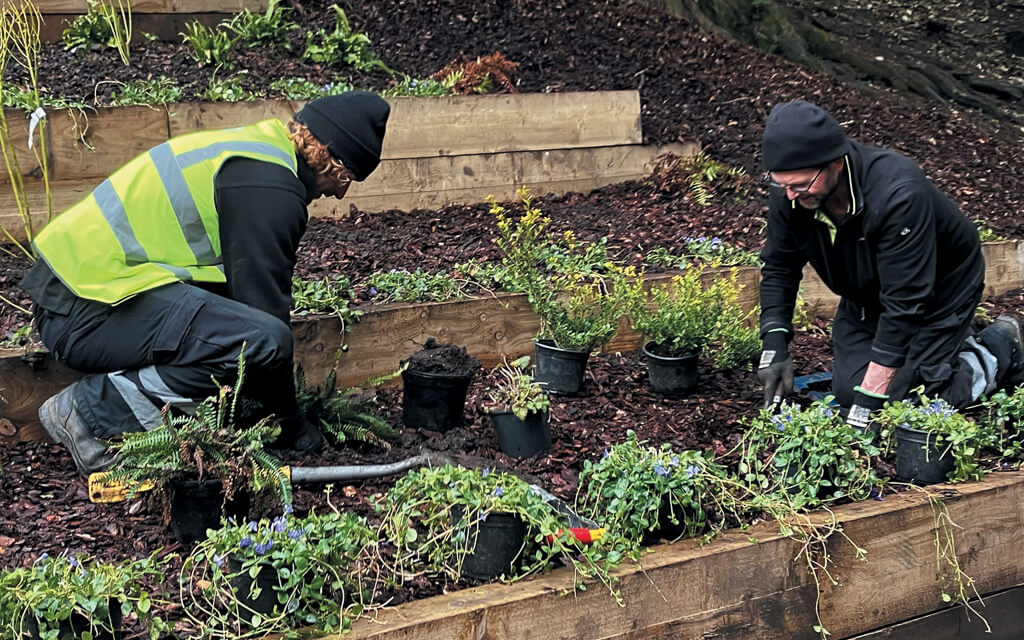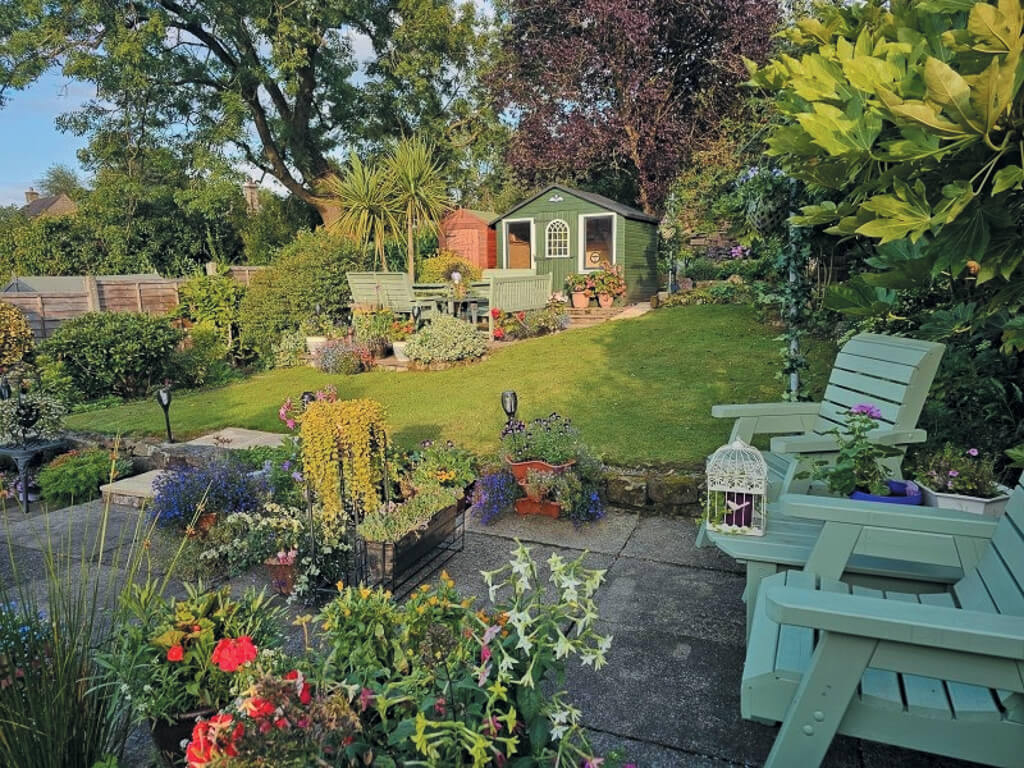DERBYSHIRE Dales District Council’s (DDDC) parks and open spaces offer residents and visitors a place for recreation, to enjoy nature and to find inspiration for their own gardens, writes Catherine Roth.
DDDC owns 28 parks, of which five are its main parks and gardens – Ashbourne Park, Bath Gardens and Rutland Recreation Ground in Bakewell, Derwent Gardens in Matlock Bath, and Hall Leys Park in Matlock. Together they offer outdoor destinations for all ages with play areas, a boating lake, mini train, skate park, tennis courts, football pitches, pleasant walks, places to sit and relax, as well as planting schemes ranging from more formal traditional flower beds to natural landscaping including areas of woodland, wildflowers and the River Wye in Bakewell and the River Derwent in Matlock and Henmore Brook in Ashbourne.

Bath Gardens has perhaps the most formal planting schemes of all the parks. Emma Mortimer, Community Development Officer for DDDC, says: “Bath Gardens in Bakewell is the smallest of our main parks, but is the horticultural jewel in the crown, with its long borders, rose garden and arbours supporting climbing roses and clematis, set within the backdrop of historic buildings. It provides the setting for many Bakewell events, including the Bakewell Day of Dance, Well Dressings and features in the photographs of many newly-wed couples.”
The formal planting in Bath Gardens and other parks is a mixture of annual bedding plants, shrubs and perennials. Emma says: “The annuals we use in the parks’ bedding schemes are derived from years of experience to produce high impact of colour and longevity. The mix of plants differ slightly in each park, with the different conditions each park has but includes marigolds, geraniums, begonias, petunias, salvias, lobelias and cineraria amongst others.” Shrubs add year-round interest, whilst perennials such as lavender, salvias, rudbeckias, echinacea, aster, phlox, bergenia, geranium, pulmonaria and hylotelephium flower each year.
For environmental reasons, DDDC has launched a three-year programme to reduce the number of annual bedding plants in its parks by two thirds – although they will still feature, particularly in planters and the formal flower beds in Bath Gardens and Hall Leys Park.
Visitors will instead see a notable increase in the number of perennials. Emma says: “The annuals are being replaced with perennials, chosen for their benefits to pollinating insects. Once perennials are established, they don’t have to be watered as there is time for the roots to grow, unlike annuals that are planted at one of the warmest times of the year. Perennials also don’t need to be replaced each year and are better suited to changes in our climate.”
In some of its open spaces, including Knowleston Gardens, watering isn’t an option. Emma says: “At some sites we can’t necessarily get the water bowsers up there, so the plants need to get on with it themselves. We have to choose the right plants for the right place.”
Climate change is presenting challenges for the team. Extremes of weather can bring hot, dry conditions or wet, cooler weather. It is the latter that has made mowing problematic this year. Earlier in the year, in particular, the ground was very wet and it was difficult to get vehicles onto the sites without damaging the soil and grass – made an ever greater challenge as the grass grew quickly in all the rain.
There are also much longer-term challenges with the need to plan ahead, not just for the next few decades but beyond. Emma says: “We carried out a tree-planting scheme in Ashbourne Park a year ago and we deliberately planted a range of trees. Trees will be here in 100 or 200 years but it’s difficult to predict how the climate will change and how trees will react – at least this way some will be able to survive and thrive.” Varieties of trees planted include oak, silver birch, alder, rowan, bird cherry, field maple, hawthorn and guelder rose shrubs.
DDDC’s parks and open spaces are managed by a team of 14, together with a small team that works with communities to develop the parks and another team that deals with the structures within the parks such as buildings, bridges, bandstands and footpaths. The large parks have a dedicated staff member who works there, whilst other staff will look after a number of smaller parks in different areas, enabling them to get to know the sites well. However, when it is time for planting, everyone joins together, as it is all hands on deck to carry out these larger tasks.
Growing annuals requires a lot of maintenance from when they are planted out at the beginning of June to when they are removed after flowering has finished in October, with plenty of dead heading and weeding in between. Emma says: “A lot of the beds are bordered by grass so we need to cut round those to keep the edging nice and neat so that the grass doesn’t fall into the plants.” There is also the pruning of shrubs, trimming hedges, mowing grass, and generally keeping the parks looking their best. Emma says: “We don’t use any chemicals – no herbicides or pesticides – so all of the weeding is done by hand.”
With so much to do, DDDC is grateful to its volunteers. Emma says: “We have really well-trained staff but they are limited to how many hours there are in a day. Having volunteers can really help.” Ashbourne Park, with its formal garden of remembrance, recreation ground of sports pitches and play area, and the more natural area of Fishpond Meadow, is one example of how the community is getting involved – from the Friends of Ashbourne Park working with DDDC on the development of the park to the u3a gardening group offering its horticultural skills. Emma says, “At Ashbourne Park, the u3a gardening group came to us as they wanted to have a bed they could garden. We created one for them and they’ve done an amazing job – it’s really beautiful, and when the bedding plants come out in October, they’ll take on another.”
At Bath Gardens and Knowleston Gardens, the EM Care Group provides volunteering opportunities. Emma says: “EM Care Group provides support and guidance for adults with learning difficulties. Their volunteers help us keep the park looking good and like the interaction with the public who say that it looks great.”
Others will volunteer only for specific projects, such as the community group that formed to fundraise when people wanted a new skate park in Hall Leys Park, and they will be involved in the opening event that will take place in the autumn. Local cubs help out by doing weeding or litter picking as part of their badge.
Emma works with local groups enabling them to enjoy the different parks and develop the sites so there is more to offer communities and visitors. As well as a space for individuals to enjoy the outdoors, the parks also provide venues for events including food festivals, live music and summer concerts, funfairs and picnics. Perhaps the most well-known of all the events is the popular Matlock Bath Illuminations in the autumn, which takes place in Derwent Gardens. Emma says: “Thermal springs emerge in the park, creating the water gardens and along with grottos and alcoves provide unique features within these beautiful gardens.”
Keen to understand more about people’s opinions, the major parks are, at present, carrying out a survey to see what improvements visitors would like to see. DDDC will look to repeat this every five years and will also look at how public opinion and the use of parks changes over time.
A notable change was evident during lockdown. Emma says: “Our parks really showed benefits during lockdown as they became really important for people. Children could play in the play areas, people could enjoy peace and quiet walking through trees and flowers. They were places for picnics and where kids could run around. Parks are really important to physical and mental health – they provide a green open space and a place for fresh air and exercise and being in nature. Parks are often taken for granted but they’re certainly important and missed if they’re not there.”
Small gardens can be delightful!

INCREASINGLY, new houses are being built with smaller gardens, and while we may enjoy visiting larger gardens and grand estates; inspiration can still be found for smaller spaces by visiting gardens open for the National Garden Scheme this month, writes Tracy Reid.
9 Hawkins Drive, Ambergate, is opening for the first time in 2024 on Sunday, August 11, from 11am until 4pm. The garden, whilst small, is packed with shrubs, evergreens, perennials and annuals. Containers brighten up the terraced patio and two small wildlife ponds are home to toads and frogs.
The garden has views over to Crich Chase, and lovely walks can be found locally, including the quieter end of the Cromford Canal or Shining Cliff Woods.
Admission is just £3.50, children admitted free and dogs on leads welcome.
The pocket-sized garden at 72 Burnside Avenue, Shirland, is another delight. As well as traditional plants, there’s a selection of tropical plants. Every inch of space is utilised, including a sedum roof. The garden is open on Sunday, August 25 and Bank Holiday Monday, the 26th.
The owners are happy to chat to you about how they have achieved all this in a small space – ask them about ‘hot composting’! Pre-booking is essential at www.ngs.org.uk
Admission is just £3 and refreshments will be served in aid of Ashgate Hospice.






